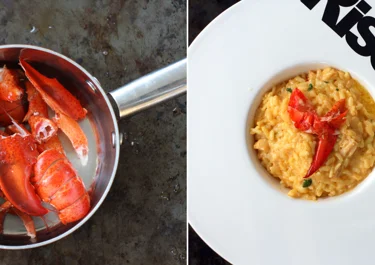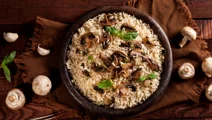Lobster risotto

Indulge in the elegance of lobster risotto. With a delicate taste of the sea, it unites fresh lobster with Arborio rice, creating a velvety and satisfying experience. Infused with aromatic saffron and a hint of bright lemon zest, this recipe brings together simple yet refined ingredients for a gourmet meal that is exquisitely memorable.
Ingredients
|
Cooked lobster
|
2 |
|---|---|
|
Butter
|
2 tbsp |
|
Shallots
|
2 |
|
Garlic cloves
|
2 |
|
Arborio rice
|
500 ml |
|
Dry wine (white or sparkling)
|
2 ml |
|
Lobster stock
|
1½ l |
|
Cream cheese
|
4 tbsp |
|
Lemon
|
1 |
|
Saffron
|
¼ tsp |
|
Fresh flat-leaf parsley
|
50 ml |
|
Pepper to taste
|
Instructions
Choosing the right lobster
For the best flavour and texture, select fresh, live lobsters. Look for those that move actively in their tanks and have firm shells, indicating they are in good health and fresh. Heavier lobsters generally have more meat. Make sure their claws are intact and that they respond to touch; these signs confirm quality and freshness.
Preparing the lobster
Start by steaming or boiling the lobster, then quickly cool it in ice water to stop it from cooking. This will keep the meat succulent and easy to handle. For lobster tails, a brief boil of 2–3 minutes is enough. Use kitchen shears to split the shell down the middle. Shears allow for a clean and simple removal of the meat, ensuring the lobster remains intact and preventing shell fragments from mixing with the meat. Make sure you use sharp shears designed for seafood, which will make this smoother and more efficient.
The right rice is key
For the perfect risotto, choose short-grain rice varieties like Arborio, Carnaroli, Vialone Nano, or Baldo, as their high starch content is key to getting a creamy consistency. Arborio is popular and widely available, offering a balanced creaminess and bite. Carnaroli releases more starch, creating an even silkier texture while holding its shape. Vialone Nano, known for its quick absorption, is ideal for risottos that need to thicken without becoming too soft. Baldo, though less common, combines a firm bite with high starch levels, ensuring a rich, smooth finish. So, you have got quite a few options to pick from.
Make lobster stock
Use homemade lobster stock as a simple yet flavourful base. After extracting the lobster meat, save the shells to make stock. Simmer them with onions, fennel, carrots, and thyme for about 1 hour to develop a deep, rich flavour. Alternatively, roast the shells in the oven for 20 minutes before simmering to intensify their taste. Strain the stock and set it aside until you are ready to use it.
Perfect risotto texture
The perfect risotto has a creamy, slightly fluid texture, with the rice grains remaining tender yet intact. It should spread gently on the plate rather than being overly thick. To achieve this, add the hot stock gradually and stir continuously, allowing the rice to absorb the liquid slowly. This process releases starch, creating the velvety consistency risotto is known for. The rice should be al dente, meaning soft but with a slight bite.
FAQ: Questions about lobster risotto
With its refined taste and luxurious feel, risotto often prompts questions about how it is made. Below, you can find answers to some of the most common questions to help you get it right.
Can I use frozen lobster tails for lobster risotto?
Yes, you can use frozen lobster tails for this recipe. Ensure they are thawed completely before cooking them to get the best texture. Slowly defrost them in the fridge to keep the meat tender and pat them dry before cooking. This helps the lobster maintain its delicate flavour when cooked.
How to store leftover lobster risotto?
Store leftover lobster risotto in a shallow, airtight container in the fridge for up to 2 days. To reheat the leftovers, add a small amount of stock in a pan or microwave to maintain the creamy texture.
Can I prepare lobster risotto in advance?
Risotto is always best served fresh. However, if you need to make it ahead, cook the risotto without the lobster and store it separately. When ready to serve, gently reheat the risotto with a bit of stock and add the lobster towards the end. This keeps the texture and taste at their best.
What to serve with lobster risotto?
Pair lobster risotto with light, fresh sides to highlight its rich seafood flavours. Dishes like roasted asparagus, a crisp spinach salad, or simple roasted vegetables bring freshness to the plate. Toasted garlic bread or lightly buttered green beans also work well, resulting in a more well-rounded taste experience.
Elegant and simple lobster risotto
Our lobster risotto showcases elegance and simplicity, from its choice of ingredients to its stunning presentation. Sweet, tender lobster combines with the creamy texture of risotto rice, forming a smooth, velvety base for the luxurious seafood.
The recipe is sophisticated enough for special occasions yet simple enough to enjoy as a treat. Perfect for when you want a touch of everyday elegance or to celebrate a memorable meal.
Succulent lobster with creamy Arborio rice
The lobster and risotto rice are the shining stars of the recipe. The lobster’s tender meat and natural sweetness infuse the risotto with aromatic seafood flavour. The Arborio rice is great for risotto, as it develops a creamy, velvety texture that envelops the lobster, allowing its delicate taste to shine through. The slight firmness of the rice grains makes for a pleasing contrast to the lobster’s tender bite. It is a culinary power couple you will be dreaming about long after the last bite.
Sweet floral hints of saffron with bright zesty lemon
Saffron pairs beautifully with the seafood and brings a delicate floral fragrance and warm colour, making the risotto feel both inviting and aromatic. Fresh lemon zest provides a bright, tangy note that balances the sweetness of saffron and adds a lively freshness. This pairing of floral and citrus elements keeps the risotto vibrant and refreshes the palate with each bite.
An extravagant dish for special occasions
Lobster risotto is an ideal choice when you want to celebrate special occasions. An intimate dinner or a festive gathering? This recipe brings a touch of sophistication to any event. Enjoy it on its own, letting the ingredients speak for themselves, or pair it with different sides. Light vegetables like roasted asparagus or sautéed green beans provide freshness and texture, balancing the richness of the risotto without competing with it.
Serve the right side dish with some of our best salad recipes like a refreshing green summer salad, a rocket avocado salad, a beautiful red cabbage salad, a quinoa butternut squash salad, or a crunchy kale chickpea salad.
Make subtle changes to the recipe
Want to make a few changes to the recipe? No problem, we even have some ideas to get you started. Instead of lobster, try some prawns or scallops for a different seafood twist. Both options work beautifully with the same aromatic stock. For an earthy note, add a light drizzle of truffle oil that complements the saffron’s warmth brilliantly.
You can also play with herbs; using dill instead of parsley offers a fresh, slightly sweet flavour, while chives introduce a gentle, onion-like touch. Feeling zesty? Replace lemon with lime for a sharper, zesty edge. A light dusting of smoked paprika on top can add a subtle smokiness that intrigues the palate.








